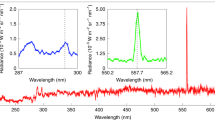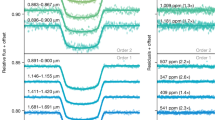Abstract
LINK1 has suggested that there is a high absorbing layer in the Earth's atmosphere. This layer, presumably dust, was suggested in order to explain the anomaly in the size of the Earth's shadow during eclipses. Some support for the suggestion came from measurements of stellar extinction from Mont Blanc2. The height of the layer has been estimated as 100–150 km above the surface and it is presumed to have a vertical optical depth of 0.025–0.05. The purpose of this communication is to show that on the basis of stellar extinction measurements made in the Gemini 9 flight, no layer at an altitude above 80 km exists with a vertical optical depth of more than 0.0015. Either Link's layer does not exist at all or it is at a lower altitude than 80 km.
This is a preview of subscription content, access via your institution
Access options
Subscribe to this journal
Receive 51 print issues and online access
$199.00 per year
only $3.90 per issue
Buy this article
- Purchase on Springer Link
- Instant access to full article PDF
Prices may be subject to local taxes which are calculated during checkout
Similar content being viewed by others
References
Link, F., Photometric Theory of Lunar Eclipses. See also Kuiper, Atmospheres of the Earth and the Planets, 87.
Bauer, E., and Danjon, A., Astronomie, 37, 214 (1923).
Author information
Authors and Affiliations
Rights and permissions
About this article
Cite this article
NEY, E., PEPIN, T. Observations on Stellar Extinction obtained in the Gemini 9 Space Flight. Nature 211, 1382–1383 (1966). https://doi.org/10.1038/2111382a0
Issue Date:
DOI: https://doi.org/10.1038/2111382a0
This article is cited by
-
High-absorbing Layer in the Terrestrial Atmosphere
Nature (1966)
Comments
By submitting a comment you agree to abide by our Terms and Community Guidelines. If you find something abusive or that does not comply with our terms or guidelines please flag it as inappropriate.



